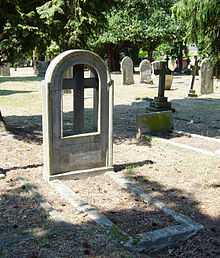Doveton Sturdee
- See also Lieutenant General Sir Vernon Sturdee KBE CB DSO, his nephew
| Sir Doveton Sturdee | |
|---|---|
 Sturdee as Vice Admiral after the Battle of the Falkland Islands | |
| Born | 9 June 1859 |
| Died | 7 May 1925 (aged 65) |
| Allegiance |
|
| Service/branch |
|
| Years of service | 1871 - 1921 |
| Rank | Admiral |
| Commands held |
HMS Porpoise HMS New Zealand Nore Command |
| Battles/wars | World War I |
| Awards |
Knight Grand Cross of the Order of the Bath Knight Commander of the Order of St Michael and St George Commander of the Royal Victorian Order |
Admiral of the Fleet Sir Frederick Charles Doveton Sturdee, 1st Baronet, GCB, KCMG, CVO (9 June 1859 – 7 May 1925) was a British admiral.
Naval career
Coming from a family of British mariners, born in Lewisham, London and educated at the Royal Naval School at New Cross, Sturdee entered the Royal Navy in July 1871[1] as a cadet on the training ship Britannia, at the age of twelve years. After two years he became a midshipman and served in the Channel Squadron and the East India Station. In June 1878, he was promoted to sub-lieutenant, and after two years at the naval gunnery school HMS Excellent in Portsmouth, he became a lieutenant and left for the Mediterranean Fleet. He took part in the bombardment of Alexandria in 1882.[1]
After completing a course on torpedoes, at what is now HMS Vernon he served as a torpedo officer on HMS Bellerophon for three years before returning as an instructor. In June 1893 he was promoted to commander and transferred to the Admiralty as Director of Naval Ordnance.[1] At the end of 1897 he was sent to the Australian Station to command HMS Porpoise, where in 1899 it fell to him to manage the tensions with Germany and the USA over the Samoan Islands,[1] earning him his promotion to captain and the appointment as a Companion of the Order of St Michael and St George (CMG).[2] He returned to the Admiralty as assistant to the director of naval intelligence and in 1902[1] was appointed Chief Staff Officer of the Mediterranean Fleet in 1905.[1] In 1906 he took command of HMS New Zealand and in 1907 he became Chief of Staff of the Channel Fleet.[1] Promoted to rear-admiral in 1910, he became Rear Admiral commanding the First Battle Squadron of the Home Fleet.[1] The following year he chaired the Submarine Committee of the Admiralty, and in 1912 took command of the cruisers of the Home Fleet.[1] Promoted to vice-admiral in 1913 he became Chief of War Staff at the Admiralty shortly before the First World War. The recall of Admiral John Fisher, to whom he had always been opposed, as First Sea Lord seemed about to blight his career.

Nevertheless, after the defeat at Coronel, Fisher sent Sturdee to the South Atlantic at the head of a powerful squadron. On 8 December 1914, whilst coaling at Stanley, he was surprised by the squadron of Graf Maximilian von Spee and the Battle of the Falkland Islands ensued.[1] Von Spee, finding that he was engaged with a superior force, was forced to flee. In the course of the pursuit Sturdee's forces sank the entire German group, with the exception of the light cruiser Dresden, which was not hunted down until some months later. For this victory Sturdee was created baronet in January 1916. He later commanded the Fourth Battle Squadron at the Battle of Jutland,[1] becoming admiral in 1917.
After the War he became Commander-in-Chief, The Nore,[1] and was promoted to Admiral of the Fleet in 1921. He was appointed Knight Grand Cross of the Order of the Bath (GCB) in the 1921 New Year Honours,[3] having already been appointed Knight Commander.
Sturdee retired to Camberley, in Surrey, and died there on 7 May 1925. He was buried in the churchyard of St. Peter's Church in nearby Frimley. His gravestone incorporates a cross made from the timbers of Nelson's ship, HMS Victory. His grandson William Staveley and grandson-in-law Edward Ashmore were also Admirals of the Fleet.
According to Anna Smith in her book "Johannesburg Street Names" (Juta, 1971), Sturdee Avenue in Rosebank, Johannesburg (South Africa), is "believed that it commemorates Admiral Sir Frederick Charles Doveton Sturdee (1859–1925) of World Ward 1 fame. The Town Engineer in writing to the township-owners on 3 November 1919 stated that Sturdee was in the 'Falklands Battle'."

See also
Footnotes
- ↑ 1.0 1.1 1.2 1.3 1.4 1.5 1.6 1.7 1.8 1.9 1.10 1.11 Liddell Hart Centre for Military Archives
- ↑ The London Gazette: no. 27154. p. 286. 16 January 1900.
- ↑ The London Gazette: (Supplement) no. 32178. p. 4. 1 January 1921.
External links
| Wikimedia Commons has media related to Doveton Sturdee. |
| Military offices | ||
|---|---|---|
| Preceded by Sir George Callaghan |
Commander-in-Chief, The Nore 1918–1921 |
Succeeded by Sir Hugh Evan-Thomas |
|